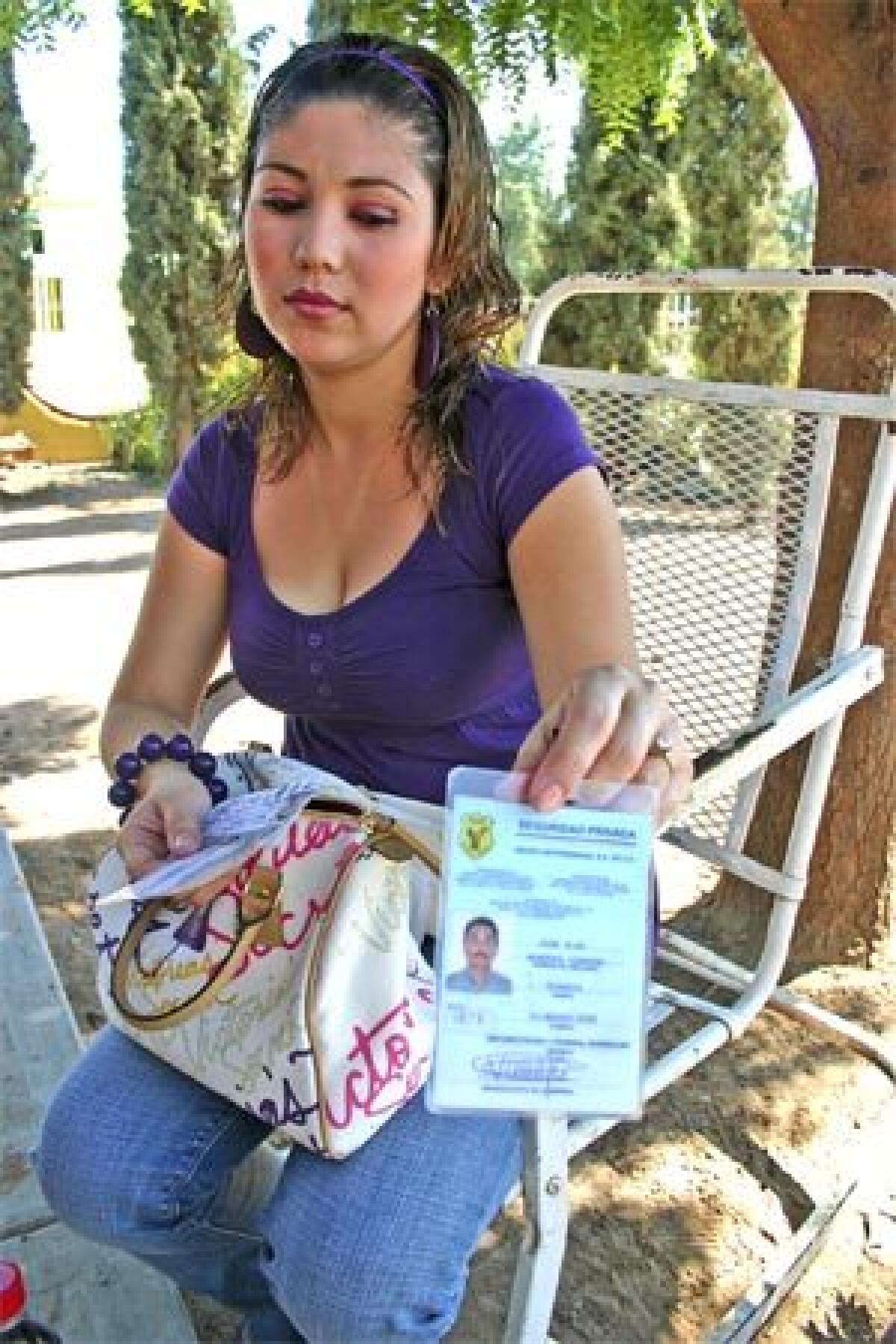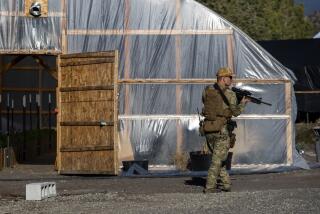In Mexico’s drug trade, no glitter for grunts

Jose Alan Montoya died far from the beloved roosters he raised on his patio, far from the tortilla shop his mother ran, far from the people who still weep for a man gunned down on a marijuana plantation in the mountains of Michoacan.
Montoya was born and raised in a humble, orderly neighborhood just outside this town in the northwestern state of Sinaloa. He died more than 600 miles to the south, shot and killed by army troops who say he opened fire on them.
Drug traffickers are mythologized throughout Mexico by a subculture that portrays them as lavishly paid gunslingers. But most of the 5,000 who have lost their lives in the last two years in the business are people of limited horizons who die in relative anonymity.
The oldest of six children, Montoya had little education. In Guamuchil, he held odd jobs at hospitals and construction sites where he rarely made more than $20 a day, relatives said.
“Someone told him he was going to make a lot of money, that he could send money to his family,” said Elva Camacho, his mother. “They must have filled his head with big dreams.”
The employees of Mexico’s drug-trafficking groups are a varied bunch, including cannon-fodder “trigger men,” drug- and cash-hauling “mules,” accountants and communication specialists.
Many sell their souls for sums that are less than princely: In October, 25 officers of the Federal Preventive Police in the city of Tampico were arrested after allegedly receiving monthly payments of as little as $450 each for providing intelligence and protection to the Gulf cartel.
No one in Montoya’s family knows how much he was offered to work for the drug traffickers. But his story is emblematic of the many myths and deceptions about the misnamed “cartels” that operate throughout Mexico.
Genaro Garcia Luna, Mexico’s top police official, said the typical drug-trafficking operative is young, 25 to 30.
“There is a tendency to give them this aura of power,” Garcia Luna said this year. “But when you have a chance to see them face to face . . . you see they are really people of low circumstances.”
In Guamuchil, Montoya lived with his mother and didn’t have enough money to put his roosters to their intended use: cockfighting. He had once crossed illegally into the United States and worked for a while in Las Vegas, but he was apparently deported.
At 33, he seemed to have few ambitions. He was an easygoing man who joked with his relatives and traveled about town on a bicycle. In the U.S., he had “Sinaloa” tattooed on his stomach.
In October 2006, he announced to his relatives that he had been hired to work on a construction project in the southern state of Michoacan.
“When I’m gone, you’ll be the oldest,” he told his 28-year-old sister, Arely, on his last day home. “Try and visit our mother every day and look after her.”
He called home from Michoacan several times. But during his three months away, he sent money home only once: the equivalent of $180 so his brother could buy a clarinet.
His mother asked him if he was eating well. “There’s a whole bunch of us here from Sinaloa,” he said. “There’s a lady who cooks for us every day.”
The family learned of his death in a local newspaper. On the Internet, they found a picture of four soldiers carrying his body, one holding each limb, as if they were dragging away an animal they had hunted. The Sinaloa tattoo was visible on his midriff. His burial cost almost $3,000, including shipping his body to Sinaloa.
Days after his funeral, an anonymous caller telephoned to promise his mother that “everything you are spending will be repaid to you.” But the family never heard from the caller again.
“Normally, the traffickers take people from here who are not involved” in organized crime, said Carlos Cota, a Sinaloa lawyer and Montoya family friend. “In the mountains, they recruit people to work from the poor neighborhoods, people who don’t have full-time jobs.”
Cocaine arrives in Mexico by the ton via sea and air routes from South America, U.S. officials say. But it’s typically smuggled into the United States by the pound. In between, drugs must be offloaded, transported overland and protected against bajadores, bands that specialize in stealing shipments from rivals.
Although “cartel” suggests that one group controls all aspects of the drug trade, drugs are actually shipped through the region thanks to alliances among local and regional crime groups.
When deals between groups are broken, violence ensues, said Luis Astorga, a Sinaloa native and Mexico City academic who has written extensively on trafficking. Gunmen and support personnel are needed to staff a large, quasi-military infrastructure.
“Given the high levels of profit in the business, [personnel] costs are very small,” Astorga said. Some traffickers have hired former special operations soldiers and high-ranking police officers, he said. But the vast majority of their employees are unskilled.
In apatzingan, a city in Michoacan notorious for drug trafficking, Claudia Cortes sold used clothes before being recruited by local traffickers to work at a safe house, neighbors and officials said.
She would later become known as the “hit woman of Apatzingan.” But in her neighborhood she was known as the daughter of a plumber and the quiet single mother of two young boys. She was 26 when she died.
“They’re honest, hard-working people,” one neighbor said of the Cortes family, who live in a cinder-block home on the outskirts of the city.
At some point, Cortes was recruited to work in another middle-class neighborhood near central Apatzingan. Neighbors there remember seeing her carrying “bundles” from the home. According to authorities, it was a base for drug traffickers.
“She was a calm person who hardly ever spoke, and who looked serious and decent,” said Maria Romero, 50, a neighbor.
On May 7, the army moved in. The people inside the safe house fired back, with submachine guns and hand grenades, officials said. The ensuing battle lasted an hour and a half.
Three soldiers were seriously wounded and four alleged traffickers inside the home were killed, including Cortes. Her body was found by the doorway of the half-destroyed home, next to an AK-47 and spent shells.
“They say she was the one who fought the hardest and who started the whole thing,” said Mario Flores, a worker in a nearby butcher shop.
Her funeral at Apatzingan’s Municipal Cemetery was a low-profile affair, without the usual graveside Mass, said Jose Cantu, the cemetery manager. It was over in about 20 minutes.
“There were only a few people,” Cantu said. “Her two boys were there. They were crying. Poor kids, it’s not their fault. But they’re the ones who suffer the most.”
The location of Cortes’ grave reveals her humble circumstances.
Apatzingan’s more illustrious families have reserved the plots near the cemetery entrance, paying an annual fee of about $200, Cantu said. But Cortes was buried in one of the cheapest plots, near the back, where the fee is $30.
A recent visitor found no name at Cortes’ plot, just a wooden cross with the words “Rest in Peace.”
Claudia’s parents have moved out of town with their grandsons because of “the shame of knowing their daughter had taken a bad road,” neighbor Horacio Cruz said.
Montoya, the collector of roosters, was also briefly in Apatzingan on his journey home: His body rested in the morgue there; sister Arely arrived from Sinaloa to identify him.
She found his hands stained green, apparently from handling the marijuana plants in his care.Tissue oozed from a gaping wound in his skull.
The authorities told her he had been shot after opening fire on army soldiers engaged in a marijuana eradication campaign near Aguililla, in the mountains 50 miles southwest of Apatzingan.
An attorney general’s news release and a newspaper report called him a “trigger man.” Soldiers retrieved two semiautomatic weapons at the scene and hundreds of rounds of ammunition.
“I told the investigator that my brother was a good man, that he had never hurt anyone, and that he was always at home when he wasn’t working,” Arely recalled.
The investigator replied, in a sarcastic tone: “Well, he wasn’t that good! He was taking care of a marijuana crop.”
Montoya was buried near his home in the Villa Benito Juarez neighborhood.
A year has passed since his death. But his 17-year-old brother, Jose Maria, still sees his older brother, known in the family as Chito, in his dreams.
In one dream, Jose Alan returns home carrying a stack of papers and walks through the front gate that leads to the patio where he raised his roosters.
“Chito, what are you doing here?” his brother calls out.
“They sent me back,” Jose Alan answers. “They let me go.”
Tobar reported from Guamuchil and Sánchez from Apatzingan. Carlos Martinez of The Times’ Mexico City Bureau contributed to this report.
More to Read
Start your day right
Sign up for Essential California for news, features and recommendations from the L.A. Times and beyond in your inbox six days a week.
You may occasionally receive promotional content from the Los Angeles Times.






